I was experimenting with Sculpey as a modeling material. It is a clay like material that you can work with your fingers and dental tools, and then bake in your home oven to firm it up. The Pillsbury Dough Boy is a famous character made of Sculpey.
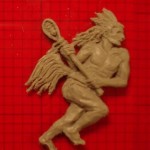
I wanted to create a lacrosse player, so I found that nice modern action shot on Google images, and then used the historic images from Wikipedia, paintings by George Caitlin.
Click on this image to see the larger view with the reference image on the left. Can you identify the model? She is number 7 on the Northwestern Wildcats women’s lacrosse team.
Postscript: The reference image for the lacrosse player is a wonderful action photo by Todd Andrew Love of player Hannah Nielsen, number 7 on the Wildcats.
Years ago I worked in fine jewelry manufacturing, where I was responsible for creating new designs, mass producing some items, casting the waxes up in gold or silver, making rubber molds of prototypes, and so forth.
Here is a short promotional video from this manufacturer, Le Monde, that shows the process. Towards the end of the video you will see me treeing up a group of waxes prior to casting and a good demo of how the lost wax casting takes place.
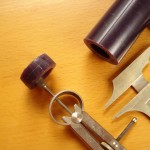
measure off a slice of wax, mark the center
For a step by step demo of the process of carving a wax, I took these photos. First you cut the appropriately sized slice from a tube of hard carving wax. Then sketch the design on the wax, keeping your center lines clearly indicated.
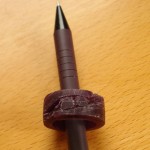
draw your design on the wax tube
Cut away the excess with saws, Xacto knives and files, working from the inside out; make the finger size right before trimming the outside of the ring shank, make the area to set the stones the exact size needed before trimming excess back towards your central focus.
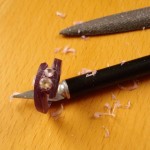
refine the shape with files and xacto knife
Refine the shape with files, sandpaper, and polish the wax with a cotton buff, and it is ready for the casting department. Click on any of these photos for an enlarged view.
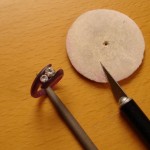
polish the wax with a cotton disk
The secret for creating a beautiful original wax? Imagine the recipient gasping with delight when they open the gift, and work backwards from that gasp. You can see some of my original jewelry creations here, along with some larger sculptural work. (Mouseover the numbers to see them.)
Creating small sculptures in glass is an interesting challenge.
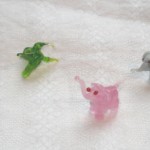
elephants and friends, click to see all
The molten glass is like taffy or honey and tends to leave strings of itself behind. You melt an initial blob to be the body, then dab on another blob at the hip, and watching carefully, pull slowly, drawing out a string of the proper thickness to form a leg, bending it into a leg shape, and then melt the excess away at the foot. Later as you are working on another leg, you must take care to not accidentally melt the first leg, or melt off the tail. It is wise to work on the biggest body parts first and leave the tiny extremities for the last.
Here are some of my baby steps in this arena; a black horse, a green hummingbird, and a trio of elephants. These are not for sale, they are just kindergarten doodles.
To see the work of master glass sculptor Pino Signoretto, and learn about his life, check out this in depth interview at the Nautica website.
“Furthermore, glass itself has something to do with the sea, in effect, to make the magic happen you need four ingredients: sand, water, air and fire, to which I would add a fifth element which is the physical energy which the artist needs to use to shape glass.” ~ Pino Signoretto
Tags: air, animal, element, fire, glass, molten, sand, sculpture, sea, water
 making glass beads, private reserve | mary |
making glass beads, private reserve | mary |  June 20, 2010 5:10 am |
June 20, 2010 5:10 am |  Comments (0)
Comments (0)





